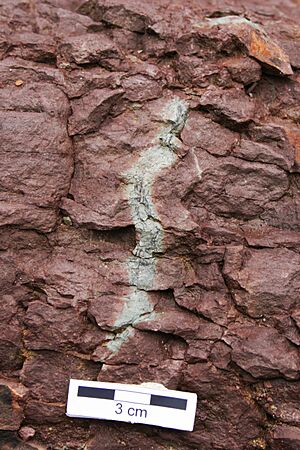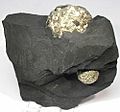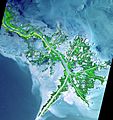Mudrock facts for kids
Mudrocks are a type of sedimentary rock that make up most of the rocks found on Earth. They are formed from very tiny pieces of minerals, like quartz, that have settled down from water or air.
You might not know it, but mudrocks are everywhere! They are the most common type of rock formed from sediments. This is because tiny bits of eroded material are the most common things left behind when rocks wear away.
There are different kinds of mudrocks, such as siltstone, claystone, mudstone, slate, and shale. The tiny pieces that make up these rocks are usually smaller than 0.0625 millimeters. That's about the size of a grain of sand, but even smaller! Because they are so tiny, it's hard to study them without special tools.
Even though these rocks might look similar at first glance, they have important differences in what they are made of and how scientists name them.
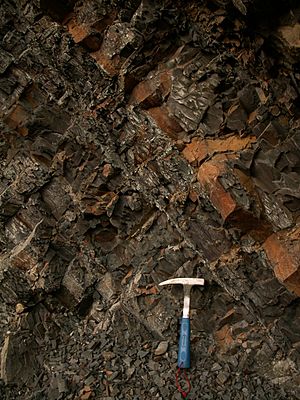
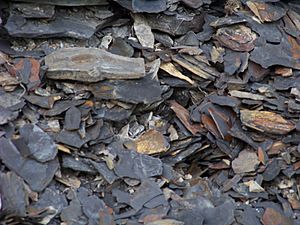
Contents
Why Mudrocks Are Important
Mudrocks have been important to people for a very long time. Even in the earliest civilizations, people used mud to make things. They made pottery and bricks for building houses.
Scientists, engineers, and even oil companies have learned a lot about mudrocks. For example, the discovery of the Burgess Shale showed how important mudrocks are for understanding ancient life and how they can be connected to finding oil.
How Mudrocks Form
Mudrocks form when tiny bits of rock and mineral, called sediment, settle down in layers. Over a long time, these layers get buried deeper and deeper. The weight of the layers above presses down on them. This pressure squeezes out the water and compacts the sediment.
As the pressure increases, the flat, plate-like clay minerals in the mud start to line up. This creates parallel layers in the rock. When a mudrock has these fine, parallel layers and can easily split into thin sheets, it is called shale. If it doesn't split easily, it might be called mudstone.
Different Types of Mudrocks
There are several types of mudrocks, named based on the size of the particles they are made from:
- Siltstone: This mudrock is made mostly of silt-sized particles. These particles are a bit larger than clay but still very small.
- Claystone: This rock is made mostly of clay-sized particles. These are the smallest particles found in mudrocks.
- Mudstone: This is a general term for mudrocks that have a mix of silt and clay. It doesn't split into thin layers easily.
- Shale: This is a mudrock that is made of very fine particles, mostly clay. It has distinct layers and can easily split into thin sheets.
- Slate: This is a type of mudrock that has been changed by heat and pressure. It's a metamorphic rock that forms from shale. Slate is very hard and splits into thin, flat pieces, which makes it good for roofing tiles.
Studying Mudrocks
It can be tricky for scientists to study mudrocks. This is because the tiny particles are so small that it's hard to see them clearly, even with a microscope. Also, there are different ways scientists classify mudrocks, which can sometimes lead to confusion.
Even with these challenges, scientists continue to study mudrocks. They are important for understanding Earth's history, finding natural resources, and even building safe structures.
Related pages
Images for kids
-
Glacial Lake Missoula claystone
See also
 In Spanish: Rocas arcillosas para niños
In Spanish: Rocas arcillosas para niños


